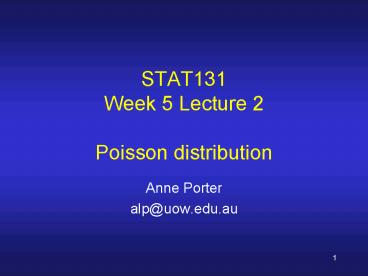STAT131 Week 5 Lecture 2 Poisson distribution PowerPoint PPT Presentation
1 / 23
Title: STAT131 Week 5 Lecture 2 Poisson distribution
1
STAT131Week 5 Lecture 2 Poisson distribution
- Anne Porter
- alp_at_uow.edu.au
2
How might the eruptions of the blowhole be
measured?
3
How might the eruptions of the blowhole be
measured?
- Number of eruptions per minute or per 15 seconds
- Time between eruptions
- Time to the next eruption
4
Poisson distribution assumptions
- When the random variable X of interests is say
the number of occurrences of a certain phenomenon
(eg eruptions of the blowhole) for a length of
time , t then the variable is Poisson distributed
if - in a sufficiently short length of time ??(say),
only 0 or 1 eruptions can happen(gt2 is
impossible). - the probability that exactly one occurrence
happens is proportional to the length of the
interval - the numbers of occurrences in non overlapping
time intervals are independent
5
Similarity to Binomial
- It is a counting distribution
- It is used as a probability model for random
experiments which satisfy a different set of
assumptions - The Poisson distribution is appropriate when the
random variable of interest is the count of the
number of times some phenomenon occurs in a fixed
period of time, provided the phenomenon occurs
at random over the time period
(Griffiths, 1999)
6
What questions will we ask about the Random
variable?
- Probability of some event P(Xx)
- Centre of Distribution E(X)
- Variance (X) ie ?2
- Standard deviation (X)
- If we have data
- How can we calibrate the model
- Do the data fit the model
7
Probability P(Xx)
- The variable X is distributed according to the
function
for x 0, 1,2,.
Where ? is the rate of occurrence of the
phenomenon per unit time
8
Example P(Xx)
- If the rate of eruptions ? is 2 per 15 seconds
then - 1) what is P(X0) per unit of time?
What is the unit of time?
t1 ie 1 lot of 15 seconds
If the question was find P(X0) in a 1 minute
period what would t be?
t4
9
Example P(Xx)
- If the rate of eruptions ? is 2 per 15 seconds
then - 1) what is P(X1) per unit of time?
10
Example P(Xx)
- If the rate of eruptions ? is 2 per 15 seconds
then - 1) what is P(Xgt1) per unit of time?
P(Xgt1)1-(P(X0)P(X1))
1-(0.1350.271) 0.594 per 15 second interval
11
Defining the Discrete Random Variable
- What do we need to define the discrete random
variable x, the number of eruptions in a 15
second interval?
Values x and the associated probabilities
What must the probabilities sum to?
1
12
Define the DRV Poisson(2)
- x P(Xx)
- 0 0.1353
- 1 0.2707
- 2 0.2707
- 3 0.1804
- 4 0.0902
- 5 0.0361
- 6 0.0120
- 7 0.0034
- 8 0.0012
13
Mean E(X)
x P(Xx) x.P(Xx) 0 0.1353 0.0000 1
0.2707 0.2707 2 0.2707 0.5414 3
0.1804 0.5412 4 0.0902 0.3608 5
0.0361 0.1805 6 0.0120 0.0720 7
0.0034 0.0238 8 0.0012 0.0088
- Or E(X) for Poisson?t
2x1 2
Sum should equal 2 Rounding 8 category
14
Probability P(Xx)
- Using E(X)??t we can use the modified version
of the formulae to find P(Xx)
for x 0, 1,2,.
Where ? is the rate of occurrence of the
phenomenon per unit time
15
Var(X)s2
- Var(X) EX2-(E(X))2
- OR
- Var(X)?t
2x1
Note theoretically we expect the EX to equal
the Variance In practice we expect them to be
similar and we can compare The mean and variance
in samples to see if they are similar When we
assess whether the data are likely to fit a
Poisson model
16
Standard deviation X?
- ie 1.414 eruptions per 15
seconds
17
Example P(Xx)
- If the rate of eruptions ? is 2 per 15 minutes
then - 1) what is P(X0) per minute?
Do you think it would be larger or smaller than
P(X0) per ¼ minute?
.00033546 Note the calculator may have used
scientific notation ie 3.3546-04 which is an
abbreviation for 3.3546x10 -04
18
If we were given a data set what other questions
would we ask?
- Can we calibrate the model to get an estimate for
?? - Does the data we have appear to fit the Model
- as specified or
- as we have calibrated it to be?
19
Calibrate the model
- Choose ? to make equal to ?t
- If the data are used to estimate the value of ?
- Then when calculating df g-p-1 for
- p is 1 when the ? estimated from the data
20
Model fit
- Use a Bar chart to compare observed and expected
frequencies - Compare observed and expected frequencies
- Calculate and use
- Informally
- Formally
- And see if this is too big for the data to fit
the model
21
Another example
- What do we have in this clip of cars?
22
Another example
Cars going in two directions
- What do we have in this clip of cars?
Potentially two Poisson processes
And if we measure by the time to the next car
or time between cars?
Potentially Two exponential processes
23
Exponential Distribution
- When we have a homogeneous Poisson process with
the rate of events ? per unit time. If the
Poisson process is observed from t0, and Y is
the time until the first event occurs then Y has
an exponential distribution.
We will continue in later lectures examining the
exponential distribution

